|
INDIA GUIDE
TRAVEL DESK
EVENTS
AIRLINES
SEARCH
|
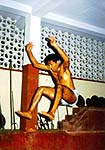
Fists of Fury
... Kalaripayattu, Kerala's martial art form
Sashi Kodasseri
 His sons Sooraj and Dhiraj are
his most dedicated sishyans. Dhiraj, who is a computer
programmer by vocation, has the lean sculpted physique of a Roman
statue. He can twist his body like a contortionist and swerve and move
with the speed of a puma. On the other hand his elder brother is
rotund and soft-faced, and he looks nothing like the expert handler of
weapons that he is. But once you see him in action, agile and flexible
like a rubber man, you wouldn't want to grapple with him for a million
rupees.
His sons Sooraj and Dhiraj are
his most dedicated sishyans. Dhiraj, who is a computer
programmer by vocation, has the lean sculpted physique of a Roman
statue. He can twist his body like a contortionist and swerve and move
with the speed of a puma. On the other hand his elder brother is
rotund and soft-faced, and he looks nothing like the expert handler of
weapons that he is. But once you see him in action, agile and flexible
like a rubber man, you wouldn't want to grapple with him for a million
rupees.
Training usually starts at the age of seven or eight. Early in the
morning after ablutions, sishyans wrap themselves in a
loincloth, over which they either wear loose shorts or a short cotton
towel. Bodies shining with coconut oil, mixed with herbs and
ghee, they jump into a pit 42 feet long, 21 feet wide and three
feet below ground level. This is the traditional Kalari (gymnasium).
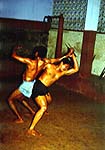 They start the day's session by prostrating before a picture of their
goddess, Bhagawati and before the gurukkal (in earlier times
all Kalaris were built next to a Bhagawati temple which is not always
the case today). For the first six months they do a set of 14 basic
exercises called meyerke. These are designed for flexibility,
agility, fluidity, bounce and to keep the joints workable in any
direction. Like a karateka, a payattu expert can turn
around and smash his foot into your face with split second timing,
without the slightest hint of it coming.
They start the day's session by prostrating before a picture of their
goddess, Bhagawati and before the gurukkal (in earlier times
all Kalaris were built next to a Bhagawati temple which is not always
the case today). For the first six months they do a set of 14 basic
exercises called meyerke. These are designed for flexibility,
agility, fluidity, bounce and to keep the joints workable in any
direction. Like a karateka, a payattu expert can turn
around and smash his foot into your face with split second timing,
without the slightest hint of it coming.
Meyerke is very difficult for the untrained person but for the
sishyan it comes naturally. They kick their legs up to a 90
degree angle till the thighs hit the chest for reach. They twist their
bodies into seemingly untwistable positions for flexibility, and kick a
ball tied 10 feet up in the air for bounce. These are just a few
meyerke exercises. Then they move on to the next set of exercises,
or rather movements, called chovude, which are similar to katas
in karate.
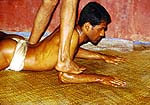 Weapon training starts with basic stick fighting or
kolathari. Generally three kinds of sticks are used -- the
short stick, the curved stick and the long stick. But in a street fight
situation they could use anything that they can grab, even a branch of a
tree could be used as a long stick (silambam in Tamil).
Weapon training starts with basic stick fighting or
kolathari. Generally three kinds of sticks are used -- the
short stick, the curved stick and the long stick. But in a street fight
situation they could use anything that they can grab, even a branch of a
tree could be used as a long stick (silambam in Tamil).
Gradually the students move on to other weapons like the straight
dagger, the curved dagger, sword and shield, spear. And finally the most
lethal weapon of them all, the urumi, a twin edged long coil of
metal which is wrapped around the waist and used like a nanchaku but
held with both hands. One wrong move and it can lop the head off. But
the constant movement makes a payattu fighter hard to touch.
From the urumi the fighter goes on to unarmed combat, at the
end of which he learns the meridian points, or pressure points, in the
body.
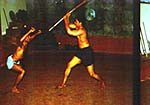 "If I touch a certain point in your body it can immobilise you," says
the gurukkal. "There are 11 points on each arm and leg, three
in the stomach, nine in the chest, 12 in the neck, 27 in the face and 14
in the back." These are mostly used when the unarmed fighter is faced
with an armed adversary and also during the therapy. A payattu
fighter does not scream like a karateka to immobilise the
opponent. Instead, it is a silent scream in the mind to derive strength.
"If I touch a certain point in your body it can immobilise you," says
the gurukkal. "There are 11 points on each arm and leg, three
in the stomach, nine in the chest, 12 in the neck, 27 in the face and 14
in the back." These are mostly used when the unarmed fighter is faced
with an armed adversary and also during the therapy. A payattu
fighter does not scream like a karateka to immobilise the
opponent. Instead, it is a silent scream in the mind to derive strength.
Massage plays a prominent role. In ancient times training was
imparted only during the monsoons. The rest of the year was spent giving
herbal massages like uzhicils ( a firm rub down of the body
using the palms and fingers) and pizhichils (kneading the body
with hands and legs) to make the body supple. A pizhichil with
the leg can be painful at first, but then the body gets accustomed to it
and adapts. After about 15 years of training when the student has
mastered the urumi and unarmed combat, he is taught herbal
medicine -- recognising and collecting herbs, their applications and
massage.
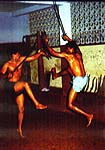 Kalaripayattu reached its most glorious (and romantic) period sometime
during the late 15th and early 16th century AD with the advent of the
Portuguese in the country. Local chieftains fighting the hordes
of Vasco da Gama, Pedro Alvarez Cabral, Francisco D'Almeida and Alfonso
de Albuquerque formed squads of payattu mercenaries for hit and
run operations against the attackers, somewhat on the lines of the
samurai in medieval Japan. Kalaripayattu reached its most glorious (and romantic) period sometime
during the late 15th and early 16th century AD with the advent of the
Portuguese in the country. Local chieftains fighting the hordes
of Vasco da Gama, Pedro Alvarez Cabral, Francisco D'Almeida and Alfonso
de Albuquerque formed squads of payattu mercenaries for hit and
run operations against the attackers, somewhat on the lines of the
samurai in medieval Japan.
Most of these fighters were from the warrior caste of Nairs. There were
other castes like Thiyyas too, but the squads were
predominantly Nair in number. In ancient times the Nairs followed a
matrilineal system of inheritance (called Marumakkathayam) and polyandry
was the norm (not anymore though). The more husbands a woman had, the
better.
Their sons grew up to be warriors. They were revered by the local
people. They carried on their person as many as 10 different kinds of
weapons, and during the initial stages of the war with the Portuguese
they massacred the invaders with their surprise techniques, or what we
call guerrilla warfare. But soon their weapons proved no match for the
gun and cannon, and Kerala fell into Portuguese hands.
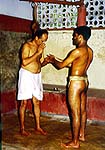 Even during earlier occupations by other mighty rulers in Kerala's
history -- Chola imperialism, for example, in the 9th century AD --
kings used squads of Nair mercenaries. According to one theory, which is
not widely accepted though, the first of the warrior castes in Kerala
were imported Thiyyas (or Ezhavas) from Sri Lanka, who at that point in
their history were a warrior clan. According to this theory Kerala
didn't have a warrior caste. The Thiyyas had been brought in by the
ruling Cheras -- from which the name Kerala is derived -- to protect the
interests of the state under a pact with the rulers of Sri Lanka, who
were being beseiged by the powerful Chola rulers of Tanjore, just like
the Cheras were.
Even during earlier occupations by other mighty rulers in Kerala's
history -- Chola imperialism, for example, in the 9th century AD --
kings used squads of Nair mercenaries. According to one theory, which is
not widely accepted though, the first of the warrior castes in Kerala
were imported Thiyyas (or Ezhavas) from Sri Lanka, who at that point in
their history were a warrior clan. According to this theory Kerala
didn't have a warrior caste. The Thiyyas had been brought in by the
ruling Cheras -- from which the name Kerala is derived -- to protect the
interests of the state under a pact with the rulers of Sri Lanka, who
were being beseiged by the powerful Chola rulers of Tanjore, just like
the Cheras were.
With the decline of Chola supremacy in the early years of this
millennium the Thiyyas were asked to protect Namboodiri brahmins
(who had migrated from the Kolhapur area in Maharashtra sometime during
the 5th and 6th century AD and thus formed the priestly caste in
Kerala). They refused. And the Nairs stepped in.
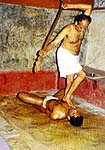 Over the years the
Thiyyas were soon reduced to climbing coconut trees for a living. Which
they did for centuries. But this theory is only speculative and has few
takers. It is a different matter altogether now, with social
reforms introduced by the reformer Sree Narayana Guru and land reform by
the Communist government in the state. You find coconut pluckers from
almost all castes in the state these days. And Kalaripayattu is not the
sole domain of the Nairs. It's universal. But are there any takers? Over the years the
Thiyyas were soon reduced to climbing coconut trees for a living. Which
they did for centuries. But this theory is only speculative and has few
takers. It is a different matter altogether now, with social
reforms introduced by the reformer Sree Narayana Guru and land reform by
the Communist government in the state. You find coconut pluckers from
almost all castes in the state these days. And Kalaripayattu is not the
sole domain of the Nairs. It's universal. But are there any takers?
Fast Facts
Those interested in the art can write to T C Chandran gurukkal or his
sons Sooraj and Dhiraj.
- Kairali Ayurveda Chyikilsa Kendram, Town
Hall road, Calicut, Kerala, India.
- Kairali Kalari Sangam,
Kottaram road, East Nadakkavu, Calicut, Kerala, India.
Photographs by Rajan Kallai
|




